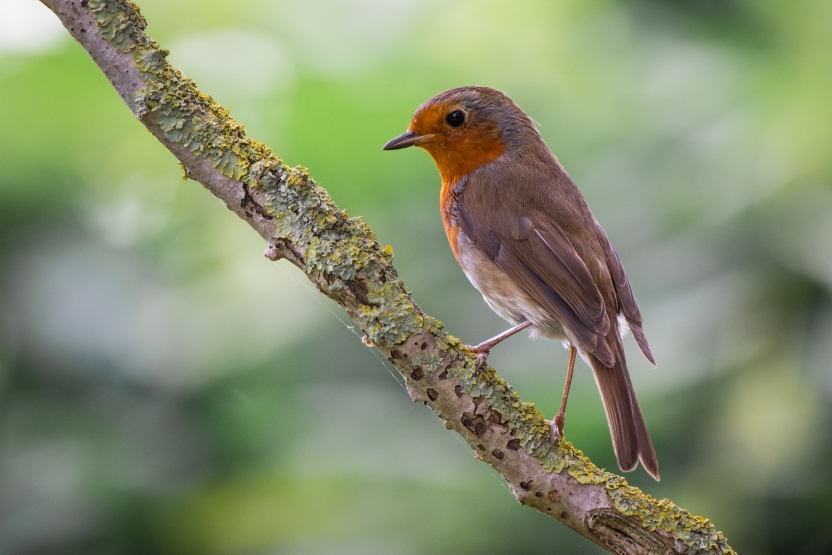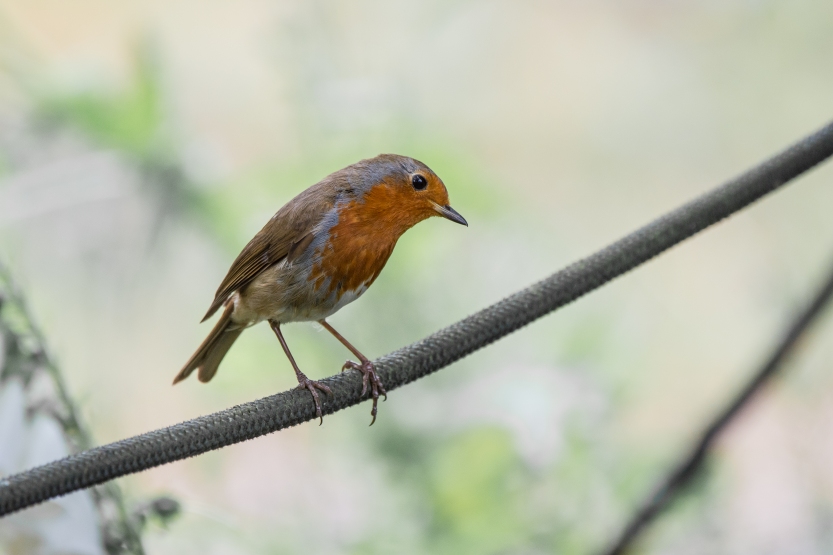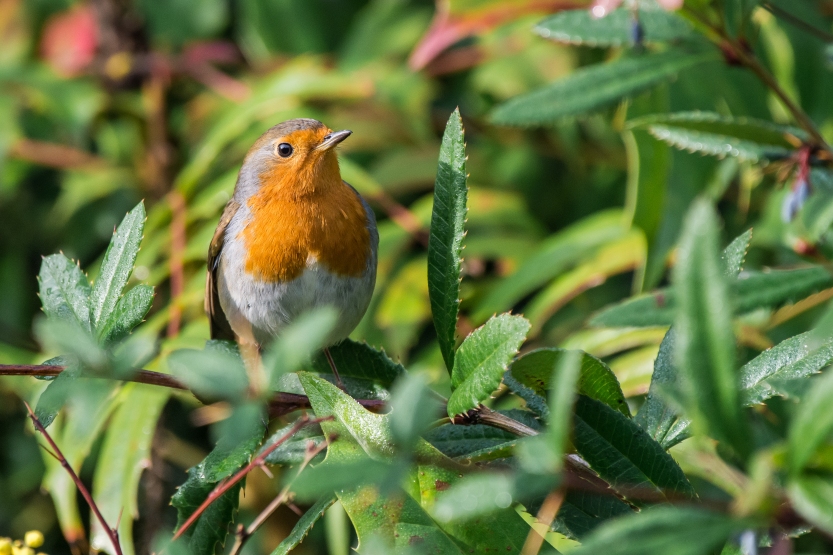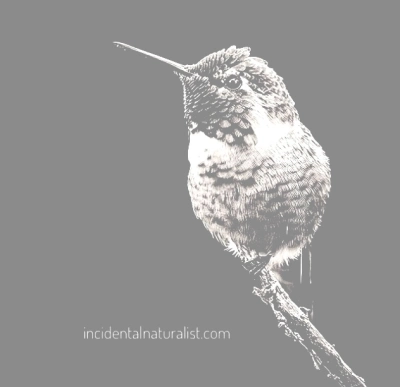The Robin, or European Robin, has been voted the unofficial National Bird of Great Britain on several occasions. The gardener’s friend, and symbol of Christmas is the most recognisable bird in the country. More importantly, it is my mum’s favourite bird. Walk through our family nest at Christmas and you will be surrounded by Robins on greeting cards and decorations, and even a scruffy aging red-breasted bird sitting firmly on the top of the Christmas tree.

Having written about the Robin’s trans-Atlantic cousin, the American Robin, I thought it high time I shared the ‘original Robin’ on this blog. The problem was that, as with so many common birds, I didn’t have any good photos. I thought that I would change that very quickly, but I only go back to the Britain a couple of times a year, and as common as the Robin is, the bird favours the dark spots of the undergrowth. But after a few hours of Robin stalking over a couple of visits, I was able to capture a few shots of these beautiful birds.


The Robin is a small bird, at around 12 cm (5.0 in) long, with a wingspan of 20 cm (8 in). Juvenile Robins are star-speckled brown, with the characteristic red breast only appearing after the first molt. Folklore says that the Robin was always a brown bird until one famous day in Golgotha, where upon he saw Jesus suffering on the cross. The Robin plucked a thorn from Christ’s head and sang to him, thus becoming stained in blood, forever carrying the mark of Christ.

The Robin has a powerful song that it uses to maintain its territory, as well as to attract a mate. In winter the female also sings, as she is as territorial as the male outside of the breeding season. The Robin song can be heard before sunrise and after sunset. As a result, the powerful song is sometimes thought to be that of its cousin, the Nightingale. Those of us lucky enough to have heard the Nightingale on a summer night know that for all the Robin’s effort, it falls well short of its drab relative’s supreme sonnets.

In recent years, my dad has repurposed a couple of old Blue tit nest boxes to make them Robin friendly. He doubled the size of the entrance, leaving it a little rough and adding footholds for the less acrobatic Robin. The boxes were relocated lower to the ground and buried in vegetation.

The neighbourhood Robin was quick to spot that these home renovations were back on the market, and when spring arrived a pair of Robins claimed one as their own. My mum provided personal security, as she sat attentively at the window, springing out of the door, Jack-in-the-box style, to flush a greedy magpie or moggy away from the nest box until the fledglings had flown.

The Robin’s association with Christmas makes it synonymous with winter. It is often depicted in art as the single splash of colour in snowy world. In reality, winter is a tough time for the Robin, as it is for all birds. The intelligent Robin recognises that where there are people there is food and warmth. It is this knowledge that has them close by in the coldest months. Their wintery presence has seen the little bird recognised in nursery rhymes throughout the ages, such as this popular rhyme that I so often heard as a child;
The North Wind doth blow,
And we shall have snow,
And what shall the poor robin
do then?
Poor thing!
He’ll sit in the barn,
And keep himself warm,
And hide his head under his wing,
Poor thing!

Gardeners who spend cold hours outside alone on chilly mornings, digging the vegetable patch, will no doubt have enjoyed the company of a Robin. The little bird will perch close by, intent on grabbing a worm or beetle, disturbed by the prongs of the fork. Winter anglers are well used to occasional visits from a Robin, cocking its head towards them, as its glance darts from bait box to angler. There are few who can resist flicking a fat juicy maggot towards a hungry beak.
The Robin’s image of being a sociable, people-friendly creature, a symbol of Christmas who perched on the cross with Christ himself, is a little misleading. In reality, these birds are fierce marauders, defending their territory with the passion and violence of a lion. 10% of all fatal injuries to adult Robins are inflicted by another murderous Robin. Any other bird that flashes a sideways glance at the red-breasted hooligan is likely to be driven from its perch.

The Robin is a bully and a loud mouth, but its confidence and willingness to follow us around the garden, combined with its simple, elegant beauty, makes this little songster a favourite. It might be a common bird, but it doesn’t stop me calling mum to the window whenever one flits through the garden to snag a snack from under the bird feeder.
A poem by William Wordsworth:
Art thou the bird whom Man loves best,
The pious bird with the scarlet breast,
Our little English Robin;
The bird that comes about our doors
When autumn winds are sobbing
_____________________________________
Join the conversation below. Do you have a Robin in the garden? 👇👇👇
It takes a lot of work to produce a blog, so I really appreciate people sharing my posts on social media. Thank you!
If you enjoyed this post, please follow Incidental Naturalist.
Categories: United Kingdom





My husband has a little ceramic version. I don’t know where he got it, but since we’re American, it took me quite some time to learn it was a European robin!
LikeLiked by 1 person
Very different birds from the American robin but both beautiful in their own way. I am still delighted to see either robin or any of their Australian cousins. It seems any bird that gets tagged as a robin is quite exquisite.
LikeLiked by 1 person
I love seeing Robins too and now have a regular visitor to my small garden in the uk. They are very friendly, this robin will stay around when I’m in the garden but the sparrows, bluetits fly off.
LikeLiked by 1 person
The gardeners friend! I think the birds that stay around are the ones that know good is t far away. Glad to hear you know how to appreciate nature in a small garden.
LikeLiked by 1 person
What a lovely post David. And here I thought English robins had really bright red breasts.
I too learned that children’s rhyme – in Oz on the other side of the world. Like most Aussies of my generation I had a good Brit heritage without even really realizing it.
Beautiful photographs. It was worth the wait.
Alison
LikeLiked by 1 person
Hi Alison, thank you for another encouraging comment! You have your own selection of beautiful robins over in Australia. I was thrilled to encounter a few of them.
LikeLiked by 1 person
Great Blog!
LikeLiked by 1 person
Thank you!
LikeLike
Great photos of a lovely, “common” bird, David =) So much to appreciate in the seemingly simple, everyday aspects of our environment. Really enjoyed the poetry you included. Your blog stories and facts always increase my knowledge base and appreciation; this time also my holiday spirit = p
LikeLiked by 1 person
Glad you enjoyed this little festive bird, Lara! Thanks for stopping by and leaving another kind comment. Best wishes for the holidays ☺️
LikeLiked by 1 person
“) And to you, David!
LikeLiked by 1 person